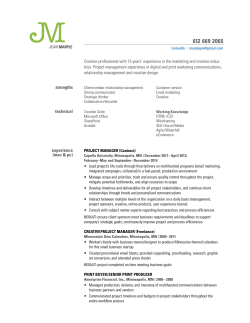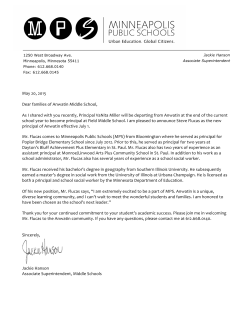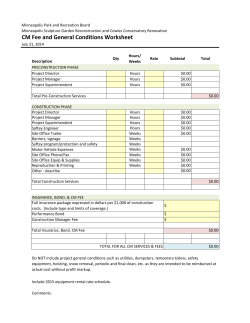
KEY FINDINGS Minneapolis continues to be a WHAT
Minneapolis continues to be a KEY FINDINGS This is the first annual update of the MINNEAPOLIS CREATIVE VITALITY INDEX (CVI) data, which debuted last year in The Minneapolis Creative Index 2013 report. The CVI data provides one way of measuring the impact of the creative sector by looking at the region’s share of creative jobs, arts spending, and creative for-profit and nonprofit organizations. It helps us track annual changes in the economic health of highly creative industries and occupations. Next year, the Arts, Culture and the Creative Economy program will release a full report containing case studies and updates for 2015. We hope this year‘s snapshot of Minneapolis’ creative sector will inform the city of current successes and opportunities in the creative sector, highlight some new information about the creative economy, and whet your appetite for our full update next year. WHAT THE CVI MEASURES MEASUREMENTS OF PER CAPITA OCCUPATIONAL EMPLOYMENT IN THE ARTS 40% 60% HOW WE COMPARE – OUR CVI SCORE MINNEAPOLIS' CVI SCORE OUTPACES THE NATIONAL AVERAGE 4.1 TIMES OVER. The Minneapolis/St. Paul metropolitan area became more creatively vital in 2013 compared to the national average: Of the 35 most populous metropolitan areas in the country, Minneapolis/St. Paul is the fifth most creatively vital, an improvement from our ranking as 6th in 2010. We saw a 2% increase in our CVI value from 2010 while other metropolitan areas' values decreased. CVI VALUE BY METROPOLITAN AREA RANK METROPOLITAN AREA 2010 2013 1 Washington, DC 2.56 2.52 2 Los Angeles 2.21 2.26 3 New York City 2.34 2.12 4 Boston 1.72 1.67 5 MINNEAPOLIS 1.51 1.54 COMMUNITY PARTICIPATION 6 Seattle 1.47 1.38 BASED ON PER CAPITA REVENUES OF ARTS-RELATED GOODS AND SERVICES 7 San Francisco 2.03 1.33 8 Austin 1.23 1.31 9 Denver 1.28 1.25 10 San Jose 1.17 1.24 MOST CREATIVELY VITAL METROPOLITAN AREA IN THE COUNTRY A RESILIENT SECTOR CREATIVE INDUSTRY REVENUES IN 2013, THE CREATIVE SECTOR CONTRIBUTED OVER $800 MILLION TO THE MINNEAPOLIS ECONOMY, A 13% INCREASE FROM 2011. $520 $311 RETAIL SALES IN THE ARTS NONPROFIT REVENUES +37% +8 MILLION CREATIVE INDUSTRY RETAIL GROWTH FROM 2009–2013 * $303 MILLION TO $311 MILLION NON-PROFIT ARTS REVENUE INCREASE FROM 2011–2013 $1,165 +2.7% MINNEAPOLIS SPENDING PER CAPITA ON THE ARTS ** TOTAL NONPROFIT ARTS REVENUE INCREASE FROM 2011–2013 Much of this increase came from art dealers and individual artist sales, which grew 62% and performing arts participation revenues, which grew 15%. Other industries had strong showings, such as music stores, which experienced an 82% increase in sales. Spending per capita on the arts in Minneapolis is nearly four times more than per capita spending in the metropolitan area, and increased 17% from 2011-13. This is in line with overall growth in per capita spending in the metropolitan area. CREATIVE VITALITY INDEX 2014 update Art Dealers & Individual Artists Performing Arts Participation Revenues Average Creative Industry Sales Book & Record Store Sales Music Store Sales Photography Store Sales TO UNDERSTAND THIS INFORMATION IN CONTEXT, RETAIL SALES IN THIS SECTOR ARE NEARLY EQUIVALENT TO THAT OF THE SPORTS SECTOR. Retail sales in the creative sector are 97% of the size of Minneapolis sports sector sales, a steep increase from 2011, when creative sector sales were 70% of sports sector sales. This change is due partly to an increase in creative sales, as well as a decrease in sports sales from 2011-13. Although we cannot make generalizations about trends that are best analyzed over time, it is clear the creative industries contribute greatly to Minneapolis’ economy. 2011 SALES 2013 SALES % CHANGE CREATIVE INDUSTRIES $432,987,414 $519,724,277 +20% SPORTS INDUSTRIES $619,848,331 $533,618,998 –14% CREATIVE EMPLOYMENT Creative employment in the region continues to be centered in Minneapolis — 26% of all creative occupations in the metropolitan area (MSA) are in Minneapolis. Creative occupations comprise around 5% of all occupations in Minneapolis. OF ALL CREATIVE OCCUPATIONS IN THE METROPOLITAN AREA ARE IN MINNEAPOLIS TOP 5 CREATIVE OCCUPATIONS 1. PHOTOGRAPHERS 2. MUSICIANS & SINGERS 3. WRITERS & AUTHORS 4. GRAPHIC DESIGNERS 5. PUBLIC RELATIONS SPECIALISTS MOST CREATIVE OCCUPATIONS EXPERIENCED AN INCREASE; the occupations that experienced the highest rate of growth were actors (7%), fashion designers (7%), sound engineering technicians (8%), and agents (10%) CREATIVE VITALITY INDEX 2014 update CREDITS GÜLGÜN KAYIM, Director, Arts, Culture and the Creative Economy CARRIE CHRISTENSEN, Project Manager, CVI 2014 Update RACHEL ENGH, Program Associate, Arts, Culture and the Creative Economy ANNA MUESSIG, Urban Planner, Gehl Studio WITT SIASOCO, Graphic Designer NOTES METHODOLOGY The Creative Vitality Index (CVI) was initially developed in 2002 in a year-long collaborative research project that included WESTAF (Western States Arts Federation) researchers, consultants at Hebert Research, the senior staff of the Washington State Arts Commission and the director of the Seattle Office of Arts and Culture. CVI data inputs were selected to be highly reliable, nationally vetted, annually updateable measures of arts participation (demand for arts products and services) and occupational employment for the arts. WESTAF recently developed The Creative Vitality™ Suite, a new online tool we used to produce this report. OCCUPATIONAL DATA Selection of occupations to be considered in the CVI was accomplished through a process of cross-walking occupations by SOC code with Department of Labor resources for matching particular skill sets with occupations. The CVI measures 36 selected occupational categories that are highly correlated with measured skill sets in thinking creatively, originality and fine arts knowledge as measured by the Employment and Training Administration’s “O*NET” occupational network database. Given this meticulous selection of occupations, the CVI presents a highly justifiable report on creative economy employment. Occupation data in the CVI come from Economic Modeling Specialist Inc. (EMSI). EMSI’s proprietary labor market data and modeling provide data on art workers who are full-time, part-time, and contract workers. This is referred to as their “complete” employment set. This employment set includes full, part-time, and contractor workers, including agricultural workers. This figure is reflected similarly, but not exactly, by Quarterly Census of Employment and Wages (QCEW) data sets CREATIVE VITALITY INDEX 2014 update frequently used by the Department of Community Planning and Economic Development. EMSI’s employment totals differ from data directly from QCEW reports because 1)EMSI does not suppress labor market data the way the Bureau of Labor Statistics (BLS) is required to and 2) EMSI’s data, while based on QCEW data, is both more current than BLS data and modeled to account for additional deficiencies in QCEW data sets. One could compare full-time creative workers to full-time workers, but the nature of art workers as regularly part-time or full-time contractors would dramatically undercount this workforce. NONPROFIT DATA Information about nonprofit arts activity is secured from the Urban Institute’s National Center for Charitable Statistics, and Economic Modeling Specialists, Inc. The Urban Institute’s National Center for Charitable Statistics aggregates information from the Internal Revenue Service’s 990 forms. The forms are required to be submitted by nonprofit 501(c) organizations with annual gross receipts of $50,000 or more. Nonprofit data from 2012 or before includes nonprofit organizations generating an income of $25,000 or more. GEOGRAPHIC DETERMINATION OF MINNEAPOLIS This report defines Minneapolis as the collection of zip codes that have all or a large share of their area within the political boundaries of the City of Minneapolis. The zip code methodology was used because of how the CVI is measured. Because the political boundaries of Minneapolis and the zip codes within Minneapolis do not align perfectly, some zip codes with extremely minimal area within Minneapolis were excluded while some zip codes with some area outside of Minneapolis were included. For a complete list of zip codes included, please contact the authors. The Minneapolis/St. Paul metropolitan statistical area (MSA) is comprised of 16 counties. In placing the Minneapolis metro area in a national ranking, we choose to compare ourselves to the 35 most populated MSAs in the U.S. (not counting Puerto Rico). This is slightly different from our MSA comparison in the previous report in which we also included regional MSAs and MSAs of comparable size. The Creative Vitality™ Suite was designed and developed by WESTAF, a regional nonprofit arts service organization, experienced research organization, and developer of technology solutions for the arts. For details on the methodology and other notes, please go to cvsuite.org.
© Copyright 2025









